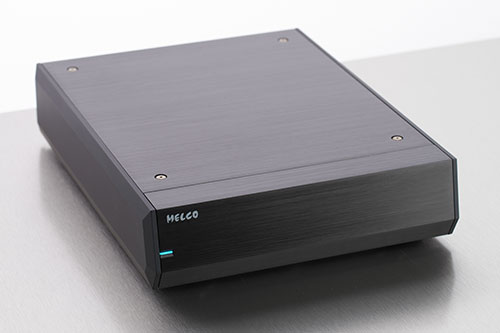Those of us with a long experience in hi-fi (and the old age that inevitably comes with it) may dimly remember the name Melco. They will associate it with a rather interesting turntable from Japan that caused quite a stirin the 1970-ies. Driven by a Pabst motor that was originally designed to be used in Swiss tape machines andwith a modular setup it certainly served as an inspiration for many other heavy mass-loaded designs, like the Audiolabor Konstant, for example. This turntable was the brainchild of one Makoto Maki from whose name derived the name of his company Maki Electronic Laboratory Company, or short: 'Melco'. After that start in hi-fi, Melco changed its direction slightly and went on to design and manufacture other electronics. Probably better know under their brand name Buffalo, they grew into being Japan's largest manufacturer of computer peripherals and a world-market leader for network routers, Ethernet switches and of course storage solutions. But Mr Maki never gave up his love for music and hi-fi and so naturally was on board when the new trend of computer hi-fi emerged. Dissatisfied with the sound quality of his own private hires audio system he then asked his engineers to come up with ideas for a truly audiophile NAS drive. This was the start of a new project that led to the development of the Melco N1A and N1Z and brought back the Melco brand.

The development project had two main goals: to create a digital music system that offered the best sound quality possible and that was very easy to set up and to use. The user was supposed to be able to use the system without ever having to connect a computer – not even when importing files or when making a backup of the stored data. To make this possible, the Melco comes with dedicated USB ports for import, backup and expansion of storage space. To meet audiophile expectations, the Melco system engineered from the ground up as a true hifi component, not as a computer. This can be seen in the way the Melco uses its ethernet ports but as I will concentrate on the use together with a USB DAC. I will leave a more detailed description of that to my colleague Roland Dietl in the secondpart of this review. Other efforts to improve the sound performance can be seen in the use of a 'Audio-grade Ultra-low Jitter Data Clock', the robust metal chassis with a massive aluminium front plate and the bespoke resonance-dampening feet courtesy of TAOC. An industry-grade power supply rated at 60W and elaborately suspended mounts for the hard disk drives complete the picture. But the true secret lies in the way that data is being handled provided for output. For this, Melco use their own software that is partially based on a heavily customized version of the Twonky UPnP server and ensures a bit-perfect transport of data with the least possible amount of jitter.

The N1A unit that I had received from Melco's German distributor, G8 & friends, came with a pre-configured wireless nano router from TP-Link (TL-WR702N). After connecting this to the ethernet port marked 'LAN' on the back of the N1A I ended up with a private wireless network that I could connect my mobile device in order to use my control app of choice. Melco recommends a number of apps to use with their devices. Unfortunately, my first generation iPad is still on iOS 5 so I ended up using my trusty Linn Kinsky app which worked like a charm. The unit had come with some gigabytes of music on the disks already so I was able to jump right in. And because that collection included a few rock gems in DSD – Tubular Bells, Dire Straits, Stevie Ray Vaughan, The Band or Pink Floyd to name just a few – my first encounter with the N1A proved to be an acoustically very satisfying trip down memory lane. But to say that I had never heard these old favouritesof mine as good as then is not really saying much at all because I never had a chance to listen to them in this format. So this was certainly a good start but there was no way around it, I needed my usual selection of music for testing. To copy this onto the Melco turned out to be no challenge at all, neither over the Wi-Fi nor via a USB pen drive. And those tracks too sounded amazing when played from the N1A. To be able to judge about how good this setup actually sounds I then went on comparing it directly with the iMac that I use for music.
But this of course not only meant comparing the Melco to the Apple computer, as the software player used has at least the same influence on the over-all sound quality as does the hardware. For the first song I used the 2.6 (4500) version of Amarra Symphony. The iMac still runs on OS X 10.9.5 and because it is a stable, reliable and well-sounding environment for all my music editing and playback needs I don't intend to change that any time soon! But that certainly wasn't the reason why Ravi Shankar's 'East Meets West' sounded noticably more crisp and clear when played from the Melco. There seemed to be a better flow to the music, and an enormous soundstage opened up in front of me. In comparison, the performance from the iMac/Amarra combination was more constricted, even a little listless, maybe. It also presented a slightly richer bass but personally I would prefer the airy and joyous enthusiasm ofthe Melco any day.





























 |
|








































































































